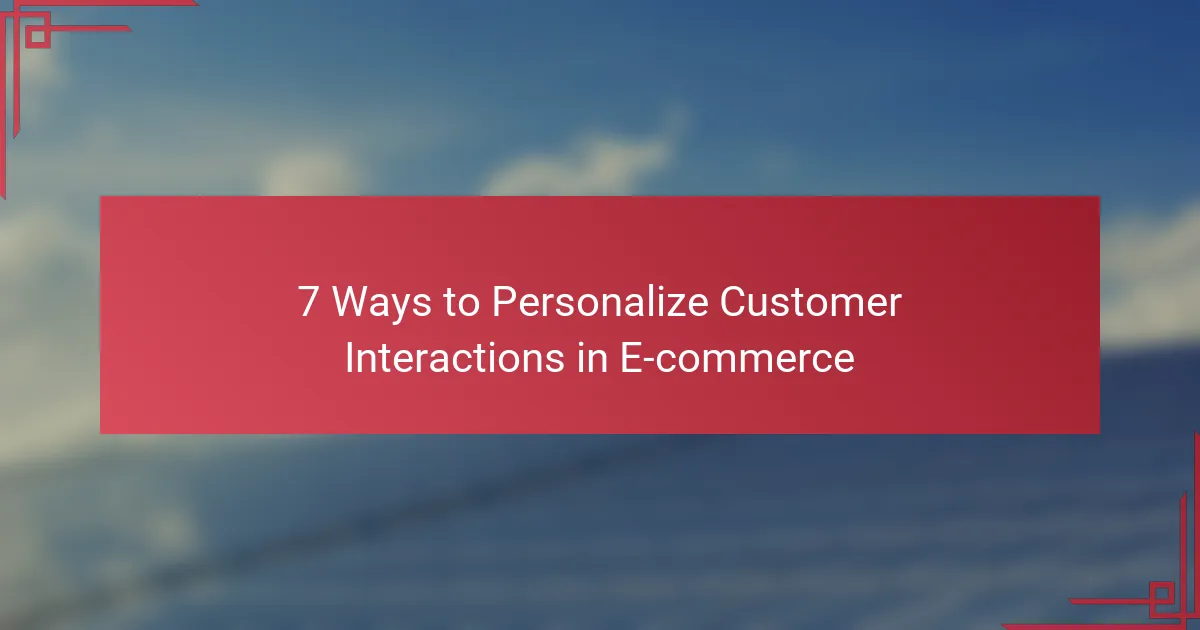In the competitive landscape of e-commerce, personalizing customer interactions is essential for fostering loyalty and enhancing satisfaction. By leveraging data and technology, businesses can create tailored experiences that resonate with individual preferences and behaviors, ultimately driving engagement and sales. Discover seven effective strategies to elevate your e-commerce personalization efforts and build deeper connections with your customers.

How can personalization enhance customer interactions in e-commerce?
Personalization enhances customer interactions in e-commerce by tailoring experiences to individual preferences and behaviors. This approach fosters deeper connections, leading to increased engagement and satisfaction among shoppers.
Increased customer loyalty
Personalized interactions can significantly boost customer loyalty. When customers feel recognized and valued, they are more likely to return to a brand. For instance, using personalized recommendations based on previous purchases can create a sense of familiarity, encouraging repeat visits.
To cultivate loyalty, consider implementing loyalty programs that reward customers for their personalized shopping experiences. Offering exclusive deals or early access to sales can further enhance their commitment to your brand.
Higher conversion rates
Personalization can lead to higher conversion rates by providing customers with relevant product suggestions. When shoppers see items that align with their interests, they are more likely to make a purchase. For example, displaying tailored promotions during checkout can effectively reduce cart abandonment.
Utilizing data analytics to understand customer behavior allows you to present the right products at the right time. A/B testing different personalized approaches can help identify what resonates best with your audience.
Improved customer satisfaction
Enhancing customer satisfaction through personalization involves creating a seamless shopping experience. By addressing individual needs, such as preferred communication channels or product preferences, you can make shopping more enjoyable. For example, sending personalized emails with tailored content can increase engagement.
Gathering feedback on personalized experiences can help refine your approach. Regularly updating your personalization strategies based on customer input ensures that you meet evolving expectations, ultimately leading to a more satisfied customer base.

What are the best personalization strategies for e-commerce in the UK?
The best personalization strategies for e-commerce in the UK focus on enhancing customer experiences through tailored interactions. By leveraging data and technology, businesses can create meaningful connections with customers, ultimately driving sales and loyalty.
Product recommendations based on browsing history
Product recommendations based on browsing history utilize algorithms to analyze a customer’s past behavior and suggest items they are likely to purchase. This strategy can significantly increase conversion rates by presenting relevant products at the right time.
For effective implementation, ensure that your recommendation engine is updated frequently to reflect the latest trends and inventory. Consider using techniques like collaborative filtering or content-based filtering to enhance accuracy.
Personalized email marketing campaigns
Personalized email marketing campaigns involve sending tailored messages to customers based on their preferences and behaviors. This can include special offers, product suggestions, or reminders about items left in their shopping carts.
To maximize engagement, segment your email list based on customer demographics or purchase history. Use A/B testing to refine your subject lines and content, ensuring that your emails resonate with different audience segments.
Dynamic website content
Dynamic website content changes based on user interactions, preferences, or location, providing a customized experience for visitors. This can include personalized greetings, tailored product displays, or localized promotions.
Implementing dynamic content requires a robust content management system and analytics tools to track user behavior. Regularly review performance metrics to adjust your strategies and ensure that the content remains relevant and engaging for your audience.

How can data analytics improve personalization in e-commerce?
Data analytics enhances personalization in e-commerce by providing insights into customer preferences and behaviors. By analyzing this data, businesses can tailor their marketing strategies and product offerings to meet the specific needs of individual customers.
Customer behavior analysis
Customer behavior analysis involves tracking and interpreting how customers interact with your online store. This includes monitoring page views, click patterns, and purchase history. By understanding these behaviors, businesses can identify trends and preferences, allowing for more targeted marketing efforts.
For example, if data shows that a customer frequently browses athletic wear, personalized recommendations for related products can be made. This not only enhances the shopping experience but also increases the likelihood of conversion.
Segmentation of target audiences
Segmentation of target audiences divides customers into distinct groups based on shared characteristics, such as demographics, purchasing habits, or interests. This allows for more effective marketing strategies tailored to each segment’s specific needs.
For instance, a retailer might segment customers into categories like “frequent buyers,” “seasonal shoppers,” and “bargain hunters.” Tailored promotions can then be designed for each group, such as exclusive discounts for frequent buyers or special offers for seasonal shoppers.
Predictive analytics for future purchases
Predictive analytics uses historical data to forecast future customer behavior, helping businesses anticipate what products customers are likely to buy next. This technique relies on algorithms that analyze past purchases and browsing patterns to make informed predictions.
For example, if a customer frequently buys skincare products in the winter, predictive analytics may suggest sending targeted promotions for winter skincare items as the season approaches. This proactive approach can significantly enhance customer satisfaction and loyalty.

What role does AI play in personalizing customer experiences?
AI significantly enhances customer experiences in e-commerce by analyzing data to tailor interactions and recommendations. By leveraging machine learning algorithms, businesses can create personalized shopping experiences that meet individual customer preferences and behaviors.
Chatbots for customer service
Chatbots utilize AI to provide real-time customer support, answering queries and resolving issues efficiently. They can handle a variety of tasks, from tracking orders to providing product information, often available 24/7, which improves customer satisfaction.
When implementing chatbots, ensure they are programmed with a comprehensive knowledge base and can escalate complex issues to human agents when necessary. This balance helps maintain a high level of service while reducing response times.
AI-driven product recommendations
AI-driven product recommendations analyze customer behavior and preferences to suggest items that are likely to interest them. This personalization can increase conversion rates and average order values by presenting relevant products at the right time.
To optimize recommendations, consider using collaborative filtering and content-based filtering techniques. Regularly update your algorithms based on new data to ensure that suggestions remain accurate and timely.
Personalized pricing strategies
Personalized pricing strategies use AI to adjust prices based on customer data, market trends, and competitor pricing. This approach can help maximize sales by offering tailored discounts or promotions to specific customer segments.
When implementing personalized pricing, be cautious of potential backlash from customers who may feel unfairly treated. Transparency in pricing strategies and clear communication about discounts can help mitigate dissatisfaction.

How can e-commerce businesses implement personalization effectively?
E-commerce businesses can implement personalization effectively by leveraging data analytics and customer insights to tailor interactions. This involves understanding customer preferences and behaviors to create a more engaging shopping experience.
Choosing the right technology platforms
Selecting the appropriate technology platforms is crucial for effective personalization in e-commerce. Businesses should consider customer relationship management (CRM) systems, data analytics tools, and marketing automation software that can integrate seamlessly to provide a unified view of customer interactions.
Popular platforms include Salesforce, HubSpot, and Shopify, which offer various features for tracking customer behavior and preferences. Evaluate these platforms based on scalability, ease of use, and the specific needs of your business.
Integrating customer feedback mechanisms
Integrating customer feedback mechanisms is essential for refining personalized interactions. This can be achieved through surveys, product reviews, and direct communication channels that allow customers to share their experiences and preferences.
Utilizing tools like Net Promoter Score (NPS) surveys or customer satisfaction (CSAT) questionnaires can help gather valuable insights. Regularly analyzing this feedback enables businesses to adapt their strategies and improve customer satisfaction over time.



